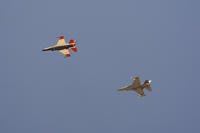Lawmakers, long skeptical of the Pentagon's plans for the deeply troubled Space Radar efforts, cut all funding for the program from the spending bill passed on Sept. 30.
"It’s a big mistake. We are going to have to find ways to move forward without the appropriators," said a Pentagon source familiar with the program. This decision would leave the U.S. vulnerable to a gap in radar coverage in coming years, according to the source, who discussed Space Radar on condition of anonymity. The program went black earlier this year, meaning that almost all program details are now classified. However, the administration did request classified funding requested for the program. I believe it was less than $150 million.
This is one of the Pentagon's top priority capabilities since it would provide what's called surface moving target indication (like what JSTARS and AWACS do). Eager to cover any possible capabilities gap, the military is moving forward smartly in designing an entirely new approach to Space Radar.
Several high level meetings about the program were held in Washington this week, including a Wednesday meeting between Air Force Lt. Gen. Tom Sheridan, commander of Space and Missile Systems Center, Los Angeles Air Force Base, Calif. and representatives of John Young, undersecretary of Defense for acquisiton, technology and logistics, and a meeting at the three-star level on Thursday to discuss the way forward. Strategic Command in Omaha is performing a capabilities-based assessment to figure out just what is really needed. That will be followed by an analysis of alternatives performed by both Young's office and the Director of National Intelligence's acquisition wing.
But make no mistake. This is not a program controlled by the intelligence community. My source said that over 90 percent of the ground and space systems of the program's funding comes from the Military Intelligence Program classified funding line. That means -- in theory and according to policy -- that the Pentagon controls the program. However, the earlier version of Space Radar died because the intelligence community and Pentagon could not agree on the program and the compromise system that resulted was so expensive not even the Pentagon was willing to ask Congress for the money.
According to a 2007 Congressional Budget Office estimate, a Space Radar constellation of nine or so satellites would have cost up to an astonishing $50 billion -- or more.
Still, Space Radar is a capability almost everyone in the military and on Capitol Hill agrees is needed and that must be built. It's when you get down to the details that everything seems to fall apart. The U.S. has dawdled for so long that we have virtually lost the capability to develop and build the satellite, according to my Pentagon source.
"We have allowed the industrial base for this capability to decay to almost zero. None of it is being developed by us. It is sickening," the source said.
Instead, the Germans, Canadians, Israelis and Italians now have excellent radar satellite capabilities. They are commercial systems and not nearly as exquisite as the intelligence community and military would like, but they can provide excellent data.
So to bridge whatever gap there might be in radar capabilities, the Pentagon now wants to buy radar data from the Israelis and Canadians, in particular. In addition, because of the flimsy state of the industrial base, the US will probably partner with one or more of those allies to build a radar satellite that does not meet the exacting standards of the intelligence community but would eventually provide surface moving target indication, according to the Pentagon source. The goal is build a system by 2012 or 2013. Perhaps most remarkable in this whole tale is the claim that this approach will allow the Pentagon to take half the money it had planned to spend on Space Radar and feed that money back into the budget. Since the amount is classified I can't tell you how much it would be. But it's serious money.
Meanwhile, the National Reconnaissance Office will build a so-called "exquisite" system capable of providing the fabulous resolution data that provides the White House with so much strategic information.








